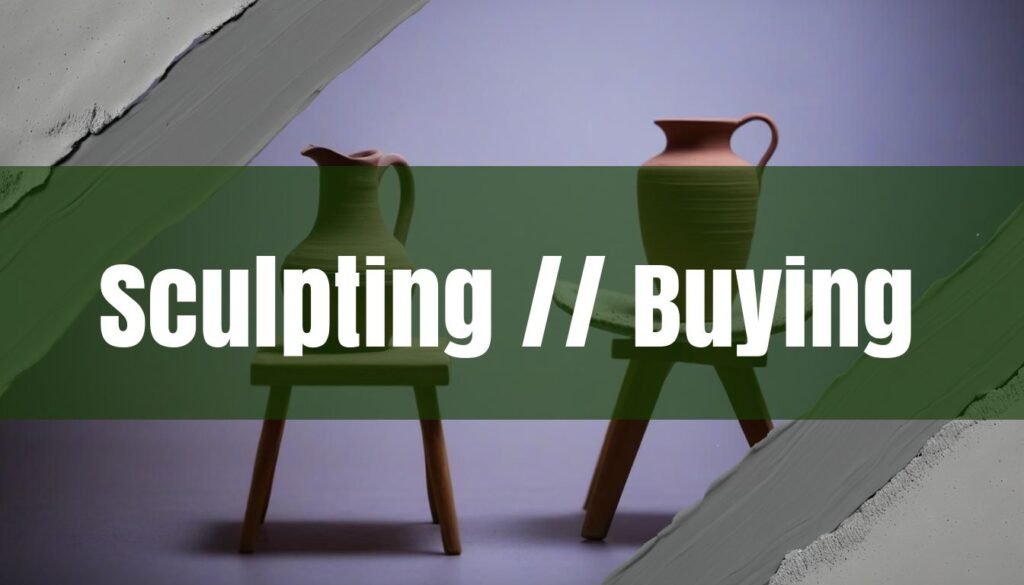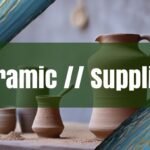Finding the perfect clay for your sculpting projects involves navigating a variety of options, each with its own set of advantages and considerations. Whether you’re a beginner just starting to explore the tactile world of clay or an experienced sculptor with specific needs, knowing where to source your materials is crucial. This article aims to guide you through the maze of choices, from local art supply stores to online retailers and specialized suppliers, ensuring you find the best clay to bring your artistic visions to life.
Local Art Supply Stores
Local art supply stores are often the first stop for many sculptors seeking clay. These stores provide the advantage of physically examining the clay before purchase. You can feel the texture, assess its workability, and ensure it meets your specific requirements. This hands-on evaluation is particularly beneficial for beginners who are still learning about the different types of clay and their properties. Furthermore, local stores offer immediate availability, allowing you to start your project without waiting for shipping. The staff can also offer advice and insights, guiding you towards the best clay for your project. However, local stores may have a limited selection compared to online retailers, and their prices might be higher due to overhead costs. Despite these potential drawbacks, the ability to see, touch, and immediately acquire your clay makes local art supply stores a valuable resource, especially for those new to sculpting.
Online Retailers
The rise of online retailers has dramatically expanded the options for purchasing sculpting clay. Websites like Amazon and specialized clay suppliers offer an extensive range of clay types, from polymer and air-dry to traditional ceramic clays like earthenware and stoneware. Online shopping provides the convenience of browsing and comparing products from the comfort of your home, with detailed descriptions and customer reviews to aid your decision. This vast selection allows you to explore different brands, textures, and properties, catering to both general sculpting needs and specialized projects. Additionally, online retailers often offer competitive prices and bulk discounts, making it cost-effective to stock up on your favorite clays. The downside, however, is the inability to physically examine the clay before purchase, and shipping costs can add to the overall expense. It’s essential to carefully read product descriptions and reviews to ensure you’re getting the right clay for your needs, and to factor in shipping fees when comparing prices.
Pottery Studios and Ceramic Supply Houses
Another avenue for acquiring sculpting clay is directly from pottery studios or ceramic supply houses. These sources often provide high-quality ceramic clays in bulk quantities, which can be particularly advantageous for experienced sculptors or those working on large projects. Buying directly from studios or suppliers allows you to access specialized clays tailored for specific firing temperatures and techniques. Additionally, these sources may offer expert advice and support, helping you choose the right clay for your intended outcome. While this option may require a larger initial investment and potentially involve travel to the studio or supplier, the benefits include cost savings on bulk purchases, access to premium clays, and valuable insights from experienced professionals. This direct approach can be particularly rewarding for those looking to establish a long-term relationship with a reliable clay source.
Different Types of Clay and Their Best Sources
The world of sculpting clay is diverse, with each type offering unique properties and uses. Air-dry clay, known for its convenience, is a popular choice for beginners and hobbyists. It hardens naturally without the need for firing, making it ideal for quick projects and classroom settings. For more insights, you might want to see this guide on choosing clay for sculpting. Polymer clay, such as Sculpey, is another popular option, prized for its vibrant colors and the ability to be baked in a conventional oven. For a beginner’s guide to sculpting in clay, Sculpey’s website offers valuable tips. Both air-dry and polymer clays are readily available at local art supply stores and online retailers.
For those seeking to create household ceramics, pottery, or earthenware, water-based clays are the go-to choice. These clays are shaped by hand or on a potter’s wheel and then fired at high temperatures in a kiln to achieve permanent durability. Water-based clays require firing in a ceramic kiln to achieve permanent durability, as explained by Sculpture Atelier. Water-based clays are typically found at specialized ceramic supply houses or pottery studios, which can provide guidance on selecting the right clay for your project and firing needs. Oil-based clay, also known as plastilina or modeling clay, remains pliable and never dries out, making it ideal for creating clay models for moldmaking and maquettes. Top brands like Chavant NSP, Van Aken Plastalina, Monster Clay, and Roma Plastilina offer high-quality oil-based clay options for sculptors, according to Sculpture Atelier. Oil-based clays can be found at art supply stores and online retailers, catering to those who need a non-drying material for long-term projects.
For creating casts, molds, or sculptures, plaster of Paris is a versatile option. It is a quick-setting powder that turns to plaster when mixed with water. More information can be found on Mont Marte’s guide to clay types. Plaster of Paris and other mold-making materials can be found at hardware stores, art supply stores, and online retailers. Ultimately, the best source for your sculpting clay depends on the type of clay you need, your budget, and your project requirements. By exploring the various options available and considering the pros and cons of each, you can find the perfect clay to fuel your creative endeavors. You may want to consider mastering storage and aging for pottery. Knowing the different types of clay can also help you choose the best material for your projects.
Tips for Assessing Clay Quality and Freshness
When purchasing clay, it’s essential to assess its quality and freshness to ensure optimal workability and results. For air-dry clay, check the packaging for an expiration date and ensure the clay is soft and pliable. If the clay feels dry or crumbly, it may be old or improperly stored. For polymer clay, look for a smooth texture and consistent color throughout the block. If the clay is hard or difficult to knead, it may require conditioning before use. For ceramic clays, inquire about the clay’s moisture content and ensure it is evenly distributed. If the clay feels too wet or too dry, it may be difficult to work with and prone to cracking.
When buying clay in bulk, inspect the packaging for any signs of damage or contamination. Ensure the clay is properly sealed to prevent moisture loss or absorption. If possible, ask for a sample to test its workability and firing properties before committing to a large purchase. Additionally, consider the reputation of the supplier and read customer reviews to gauge the quality of their products and service. By taking these precautions, you can minimize the risk of purchasing substandard clay and maximize your chances of a successful sculpting experience.
Whether you’re a beginner or an experienced sculptor, the journey of finding the perfect clay is an ongoing exploration. By understanding the different types of clay available, exploring various sources, and assessing clay quality and freshness, you can equip yourself with the knowledge and resources to bring your artistic visions to life. So, go ahead, dive into the world of sculpting, and let your creativity flow!





